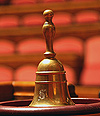The President's institutional powers
The President:

- deputises for the President of the Republic in all cases in which he/she cannot perform his/her functions (art. 86 of the Constitution);
- is heard by the President of the Republic, similarly to the President of the Chamber of Deputies, before dissolving Parliament or just one House (art. 88 of the Constitution);
- represents the Senate;
- regulates the work of all its bodies;
- chairs the debates and puts questions to the vote;
- decides on the voting order and announces the results;
- has the power to maintain order and ensure smooth proceedings according to the Rules of Procedure.
Election
 In the first two ballots, a candidate must obtain an absolute majority of all members of the Senate in order to be elected. If no candidate secures an absolute majority after two ballots, a third ballot shall be held in which it will be sufficient for a candidate to obtain an absolute majority of the votes actually cast by the present Senators; if no candidate secures such majority in the third ballot, a runoff ballot shall be held on the same day, in which the candidate securing the largest number of votes, even though with a relative majority, shall be declared elected. In the event of a tied vote, the older of the two candidates shall be elected or entered for the runoff ballot.
In the first two ballots, a candidate must obtain an absolute majority of all members of the Senate in order to be elected. If no candidate secures an absolute majority after two ballots, a third ballot shall be held in which it will be sufficient for a candidate to obtain an absolute majority of the votes actually cast by the present Senators; if no candidate secures such majority in the third ballot, a runoff ballot shall be held on the same day, in which the candidate securing the largest number of votes, even though with a relative majority, shall be declared elected. In the event of a tied vote, the older of the two candidates shall be elected or entered for the runoff ballot.
The election of the President is held during the first sitting of the Senate, which must take place by the twentieth day after general elections.
Following the election of the President, at the next sitting, the Senators shall elect four Vice Presidents (who deputise for the President to chair debates and represent the Senate at official ceremonial events), three Quaestors (who act with joint oversight in the matters of Senate services, protocol and policing, and manage Senate funds) and a minimum of eight Secretaries -whose number may increase to represent all parliamentary groups- (who, among other things, assist the President during sittings reading the texts of the bills, checking the voting results, overseeing the drafting of the minutes of public sittings). The Bureau, formed by the Vice Presidents, Quaestors and Secretaries, is chaired by the President and has total decision power as far as administration and order are concerned. In addition, the members of the Bureau appoint the Secretary General of the Senate, top officer of the Senate administration.


